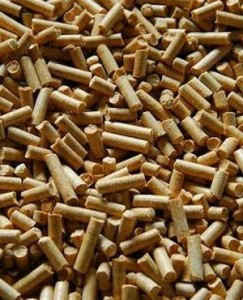Wood Pellets vs Firewood Logs
For those who love wood heat, but don’t want to put up with the some of the hassles of burning firewood, a wood pellet stove may be a solution. Instead of burning traditional firewood logs, a pellet stove burns small wood pellets that are made by compressing small pieces of wood or sawdust into cylindrical pellets.
Advantages of Heating with a Pellet Stove
One of the biggest advantages of heating your home with a pellet stove is convenience. You don’t have to deal with the constant chore and the mess of bringing in firewood and stoking the fire. Once you dump the pellets into the stove’s hopper, you don’t have to continually feed it the way you would with a traditional wood stove.
The pellet stove automatically feeds the pellets into the burning chamber at just the right rate to produce the amount of heat that you want. Pellet burning stoves are thermostatically controlled to maintain the temperature you choose. This means no getting up in the night to put wood on the fire, and no coming home to a cold house after you have been away for a while. This prevents the big temperature swings you can get with a wood stove, as one minute it is putting out too much heat, the next minute not enough.
Pellet stoves are more efficient than traditional wood heat. The combustion takes place in a smaller combustion chamber where it is more controlled, given just the right amount of air for more complete combustion. This results in more heat and fewer emissions. Pellet burning stoves are some of the cleanest heating appliances available, and maybe the cleanest burning solid fuel available.
Pellet stoves are easier to keep clean. They produce very little ash, and don’t have the problems with the creosote buildup that a traditional wood stove has. Pellets typically come in plastic bags to seal out moisture, they are not messy like firewood can be. Pellets are highly compressed, more dense, therefore take up less space to store than natural wood.
A pellet stove is easier and less costly to install than a wood stove. Pellet stoves don’t need a flue like a wood stove or fireplace does. It only needs an exhaust vent, which can be easily routed through a wall. Because of this, pellet stoves can be installed in more places where a wood stove might not be practical. Since they burn clean, you can have the comfort of wood heat, even in locations where wood stoves are not allowed because of air quality problems.
Disadvantages of Pellet Burning Stoves
The main disadvantage of using pellets to heat your home is they rely on electricity to operate some of the components. The amount of electricity they use is minimal, but this can become a problem where an electrical supply is not available, or in a power outage. But there are backup systems available, such as generators or battery systems.
Another disadvantage is producing wood pellets is a more sophisticated process than producing firewood. It requires more expensive equipment than it does to make traditional firewood. Just about anyone can make firewood if they have a saw and a supply of trees or logs. As wood pellet is a relatively new and developing industry, there have been problems in the past with wood pellet shortages in some areas. But as more pellet mills are going into production, supplies are becoming more stable.


i installed rdiaant baseboard heaters in my house. they work well and were cheap. i think they cost a little more than a gas furnace but the initial cost is much less. i found them at some surplus website, plus i bought some used ones off ebay. they run on 220 and are permanent, not a space heater. i put thermostats on each of them.
I am looking for a stove that you can burn pellets or cut wood either one.